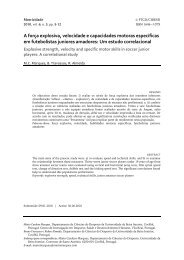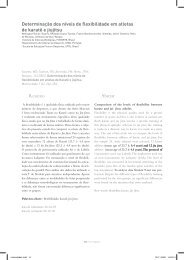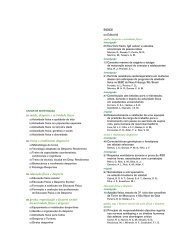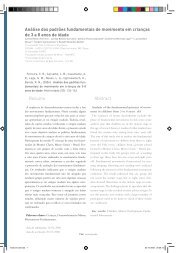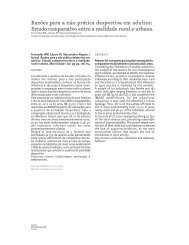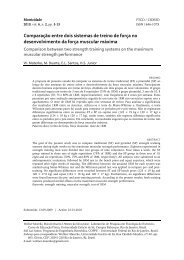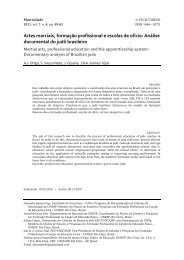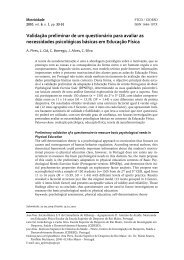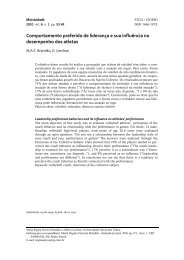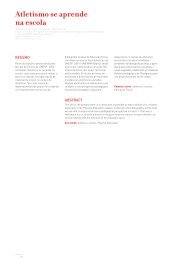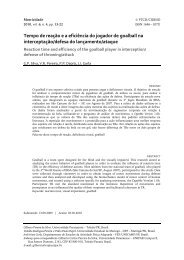revista motricidade
revista motricidade
revista motricidade
- No tags were found...
Create successful ePaper yourself
Turn your PDF publications into a flip-book with our unique Google optimized e-Paper software.
46 | R. van den Tillaar<br />
RESULTS<br />
At the pre-test no significant difference<br />
between the three groups were found in the<br />
parameters age, weight and height (Table 3; F<br />
≤ 2.1, p ≥ .12). Furthermore, no significant<br />
differences were found at the pre-test between<br />
the three groups for the maximal peak forces<br />
in the isometric situation (F = 1.6, p = .20)<br />
and the isokinetic extension (F = 2.1, p = .12)<br />
and flexion (F = 1.6, p = .21) of the knee (see<br />
Table 3).<br />
For the dynamic strength (isokinetic<br />
extension and flexion) no significant increase<br />
was observed after 6 months of training (Table<br />
4). However, a training x group interaction was<br />
found for the peak force of the isokinetic<br />
extension parameter, which showed that the<br />
control group had another development of<br />
peak force compared to the other two groups<br />
(Table 4; Fig. 2). Pos hoc comparison showed<br />
that both WBV training groups increased their<br />
peak force in extension and flexion the first 3<br />
months (Fig. 2), while the control group did<br />
not change their peak force during the whole<br />
training period (Fig. 2).<br />
The isometric strength was increased<br />
significantly after 6 month for the whole group<br />
(Table 4). However, pos hoc comparison<br />
showed that both WBV training groups had a<br />
significant increase in peak force with no<br />
Figure 2. Mean (SD) peak force during isokinetic<br />
extension and flexion of the knee averaged per<br />
group at the pre-test, after 3 months and after 6<br />
months of training<br />
significant difference between the groups (p ><br />
.05), while the control group did not have any<br />
significant changes (Fig. 3). In both WBV<br />
training groups also the gain in isometric<br />
strength (15.7 %) was significantly higher (p <<br />
.001) compared to the gain in isokinetic<br />
strength (9.4%).<br />
Table 3<br />
Anthropometrics and maximal peak force of all groups at the pre-test (Mean ± SD)<br />
Group<br />
WBV group rec WBV group hor Control group<br />
n = 67 n = 31 n = 12<br />
Weight (kg) 70.2 ± 11.8 65.7 ± 7.1 71.8 ± 14.3<br />
Height (m) 1.68 ± .06 1.66 ± .06 1.67 ± .04<br />
Age (yr) 62.2 ± 5.5 60.7±8.1 59.8 ± 4.0<br />
Peak force extension (N) 293.0 ± 62.4 280.7 ± 49.2 320.9 ± 40.7<br />
Peak force flexion (N) 206.3 ± 54.8 185.7 ± 52.8 198.1 ± 41.6<br />
Peak force isometric (N) 410.9 ± 97.1 380.5 ± 90.5 429.7 ± 64.4



